Playing
with parsers and talking with text ...
Tim Miller remembers the long-gone days of the text
adventure.
James
Sutherland's sig currently reads "You are standing
at the end of a road before a small brick building."
For those unfamiliar with that phrase, you can see
it by visiting this link,
and starting the game. It's the first line of Adventure,
the first-ever text adventure, or interactive fiction
game. Over the past 25 years it's spawned an entire
genre, more than one in fact, and yet nowadays you
can't find a
single text-adventure to buy in any shop.
Well,
that's not exactly true. Of the genres that Adventure
founded, several are just about still around, although
they've evolved almost beyond recognition. Full
Throttle, Monkey Island, the Hitchhikers'
Guide to the Galaxy, Dizzy and Zork
... all belong to the same family of game, though
at first you wouldn't believe it. But all consist
of finding objects, using them in different places,
and trying to open new locations to explore.
Development of the First
Will
Crowther has two technical programming achievements
to his name - he wrote much of the assembly code which
the Internet uses to control its routers, and he wrote
much of the original Adventure. The latter
was a pet project for him - in an attempt to stay
in contact with his daughters after his divorce, he
designed a game for them to play based on the real
caves he and his former wife had explored together.
After designing the original on paper, Crowther started
to program a game in FORTRAN.
"
... the caving had stopped, because that had become
awkward, so I decided I would fool around and write
a program that was a re-creation in fantasy of my
caving, and also would be a game for the kids, and
perhaps some aspects of the Dungeons and Dragons that
I had been playing," said Crowther in a
recent interview. "My idea was that it would
be a computer game that would not be intimidating
to non-computer people, and that was one of the reasons
why I made it so that the player directs the game
with natural language input, instead of more standardized
commands."
It
was this use of a natural-language parser which meant
that the game took off like wildfire - that, and the
fact that it was distributed for free. The game was
installed on computing lab machines all over the world,
normally without the knowledge of the system administrators.
One
such copy was found in 1976 by Don Woods. He was immediately
hooked, and after a long period he decided to contact
Crowther to ask permission to expand and improve the
game. To do this, he sent an email to crowther@* -
that is, an email to every known sitename on the Internet.
Crowther
responded, agreed, and the game was expanded to become
the original Adventure.
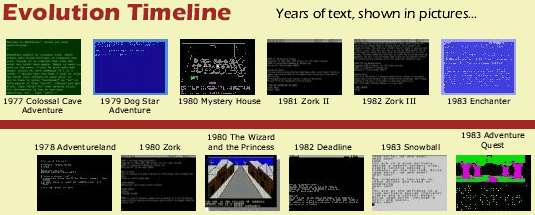
The
game was commercially released in 1891, on the Unix
platform. When IBM released their PC, the game was
included in the package by default.
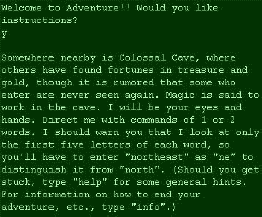
The
Early Years
The
success of Adventure, by now known as the Colossal
Cave Adventure, inspired many to start working
on their own text adventures, or "interactive
fiction". A group of graduate students at MIT
worked together to produce Dungeon, which was
later renamed Zork when the students formed
their own company, Infocom, to release the game.
"When
Zork was originally written, it was not intended
to be a commercial product", said Marc Blank,
one of the original authors. "When Infocom was
founded, in 1979, we certainly expected that the game
would be popular, but I don't think we dreamed that
it would have the success that it finally achieved."
Zork
spawned two direct sequels and countless spinoffs.
Infocom didn't stick with just the one game series,
though - during the 1980s the company produced 31
text adventures, and 4 "graphic" adventures
- text adventures with illustrations for each location.
They were exceptionally successful,
in main due to the quality of their games. A Google
search for Infocom will show just how large a following
they acquired.
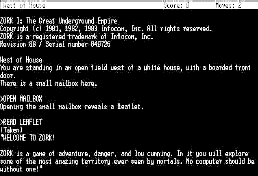
Infocom
wasn't the only company in the area. Partially in
response to the success of Infocom, a group of British
programmers formed Magnetic Scrolls, which concentrated
on the graphical adventures that Infocom tended to
avoid. The quality of Magnetic Scrolls games was generally
thought to be unsurpassed; although the descriptions
of locations were lacking compared to Infocom adventures,
the graphical additions made up for it considerably.
Another company involved in the scene was Level 9
- founded in part to release the original Adventure
on British computers.
The
ultimate step for text adventures came in 1986, when
Incentive Software released the Graphic Adventure
Creator (GAC) - an application which allowed users
to easily and freely create their own adventures.
Along with PAW and Quill (two similar
applications), this meant that the market was flooded
with rubbish at first, but some excellent games were
eventually produced, often in response to competitions
run in magazines.
By
this time, text adventures were quite different to
role-playing games, which invariably involved stat-building
and battling. Adventuring and RPGing were to take
two quite different paths.
Maturing the Concept
When
adventures moved onto the 16-bit computers, they evolved
further. Initially the games were the same as released
on the 8-bits, with better graphical locations, but
that changed when Sierra released text-based games
with interactive graphics, such as the King's Quest
series. A further step was taken by Lucasarts with
Maniac Mansion, which used an interface called
SCUMM (the SCripting Utility for Maniac Mansion).
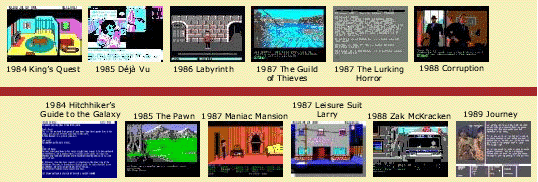
SCUMM
was a breakthrough as it moved the control from the
keyboard to the mouse. Instead of typing "open
door", the user was required to click on the
word "open" on the control panel, and then
click on the door. The era of point-and-click adventures
was beginning (while this had previously been used
in a game called Deja Vu, it was then unintuitive
and clumsy).
Lucasarts
remained at the forefront of point-and-click adventures
for years, using their SCUMM system, combined with
humour. Monkey Island, Sam & Max,
and Day of the Tentacle were universally praised,
and sold very well. Indeed, Lucasarts had so strong
a hold on the market that it wasn't until
1996, when Revolution Software released Broken
Sword, that a rival adventure sold in appreciable
numbers.
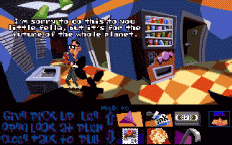
End
of an Era
Which
brings us to the present. Where are text-based adventures
now? Well, they're not. Monkey Island 4 and
Broken Sword 3 are abandoning the point-and-click
interface and becoming a game where you directly control
the character. This has been done before, of course
- the Dizzy games had exactly the same idea.

But
adventures are still around, outside the commercial
games scene. GAC games are still released from time
to time to be played by emulation. Many of the older
text games can be played
online, via Java. A game where you have to use
your imagination is becoming a rare thing, but it'll
never disappear.
>Go
North
Beyond
the Balrog was originally published in issue #3 of
ugvm magazine.
Read this article and other great content in every
issue of ugvm
magazine
online.

